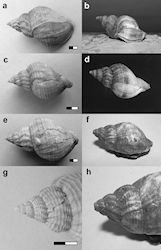
Most of the whelks had unusual features on the lip of the aperture or (less commonly) to the outside of the last whorl (Figure 9). Damage could be slight: in ten whelks, a check in growth was marked by an abrupt step along the entire aperture, with the inner nacreous lining just visible on the surface (Figure 9a); four whelks had two or three such growth-checks followed by short periods of normal growth near the margin. Moderate damage was more common: in 15 whelks, the lip of the aperture had one or two cracks over 5mm long, or a chip over 3mm missing, but normal growth of the shell had resumed (Figure 9c). Damage could be severe: in 11 whelks, numerous cracks had propagated from the lip into the body-whorl, and large fragments of the lip or body-whorl had been detached, and in some cases re-cemented into the shell by the living animal (Figure 9e). Moderate or severe damage in the spire showed a whelk had survived damage when considerably younger (Figure 9g); 11 whelks had survived once before, seven had survived twice or three times, and one had survived four times; one unfortunate whelk had survived five episodes.

Repaired shell damage is characteristic of whelks subjected to intensive bottom-trawling (Cadée et al. 1995, 338), and analogous shell damage was done by bottom-trawling in modern whelks (Mensink et al. 2000, 56). While the slight damage could be caused by infection, attack by a predator, or some other trauma, it is common in bottom-trawled whelks (Figure 9b) (Mensink et al. 2000, 55). The moderate and severe types of damage are characteristic of bottom-trawling (Figs 9d, 9f), and absent in whelks harvested by potting (Mensink et al. 2000, 55). Repeated slight damage is also a feature of whelks that are regularly bottom-trawled (Figure 9h).